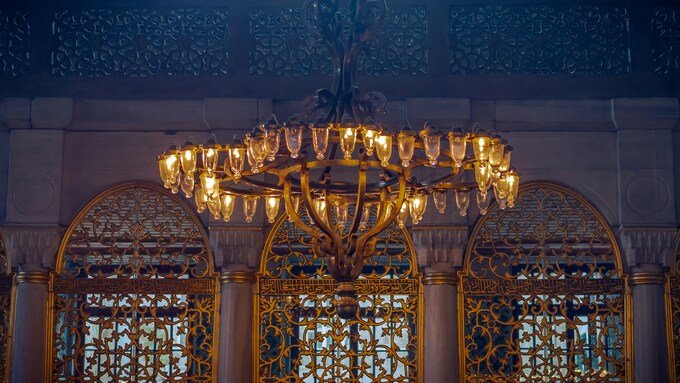Unveil the splendor of Ottoman Empire art! Explore architectural marvels, calligraphy, ceramics, textiles, and more. Discover the legacy of Ottoman art today.
Ottoman Empire Art: Exploring a Rich Cultural Heritage
The art of the Ottoman Empire is a testament to its rich cultural heritage and the diverse influences that shaped its artistic expressions. From architecture to calligraphy, ceramics to textiles, the Ottoman Empire produced a wide range of art forms that continue to captivate and inspire. In this section, we will provide an overview of Ottoman Empire art and explore the influences that shaped its unique character.
Overview of Ottoman Empire Art
Ottoman Empire art encompasses a vast array of artistic traditions that flourished during the empire’s reign from the 14th to the early 20th century. This period saw the emergence of a distinct Ottoman artistic style, characterized by its grandeur, elegance, and attention to detail. The empire’s art forms reflected the cultural, religious, and political context of the time.
One of the defining features of Ottoman Empire art is its strong influence from Islamic artistic traditions. Islamic art, with its emphasis on geometric patterns, arabesques, and calligraphy, played a significant role in shaping Ottoman artistic expressions. Additionally, the empire’s art was influenced by the artistic traditions of the Byzantine and Persian civilizations, resulting in a unique fusion of styles and techniques (Source).
Influences on Ottoman Art
The art of the Ottoman Empire was shaped by various influences, both internal and external. The empire’s Islamic heritage provided a strong foundation for artistic expression, with the Quranic prohibition on figurative representation leading to a focus on geometric patterns, arabesques, and calligraphy.
Furthermore, the art of the Byzantine Empire, which preceded the Ottoman Empire in the same region, exerted a significant influence on Ottoman art. Byzantine artistic traditions, such as the extensive use of domes and arches, influenced the architectural marvels of the Ottoman Empire.
Persian art also left its mark on Ottoman artistic expressions. The intricate designs, vibrant colors, and floral motifs found in Persian art found resonance in Ottoman ceramics, textiles, and manuscripts.
By integrating these diverse influences, the Ottoman Empire developed its own unique artistic language, combining elements from different cultures to create a distinct visual identity.
As we delve deeper into the specific art forms of the Ottoman Empire, such as architecture, calligraphy, ceramics, textiles, and metalwork, we will witness the remarkable beauty and craftsmanship that emerged from this rich cultural heritage.
Ottoman Empire Architecture
The architectural achievements of the Ottoman Empire are considered masterpieces of their time, reflecting the rich cultural heritage and grandeur of the empire. Ottoman architecture is characterized by the extensive use of domes, arches, and geometric patterns, resulting in stunning structures that continue to awe and inspire to this day (Britannica).
Architectural Marvels of the Ottoman Empire
One of the most significant architectural achievements of the Ottoman Empire is the Hagia Sophia, located in Istanbul. Originally built as a Byzantine cathedral, the Hagia Sophia was later converted into a mosque and eventually became a museum. It stands as a testament to the empire’s ability to blend different architectural styles seamlessly. The Hagia Sophia showcases the empire’s mastery in creating grand domes, intricate mosaics, and imposing arches that exemplify the grandeur of Ottoman architecture (Britannica).
Another iconic Ottoman architectural marvel is the Topkapi Palace, also situated in Istanbul. This palace complex served as the residence of the sultans and the administrative center of the empire. The Topkapi Palace showcases the opulence and grandeur of Ottoman architecture, with its stunning courtyards, ornate decorations, and intricate tilework. It stands as a testament to the empire’s architectural prowess and its ability to create majestic structures that blend seamlessly with the surrounding landscape (Britannica).
The Influence of Islamic and Byzantine Art
Ottoman art and architecture were heavily influenced by Islamic and Byzantine art styles. The empire’s conquests brought them into contact with various cultures and artistic traditions, which they incorporated into their own unique blend of decorative and architectural elements (Study.com).
Islamic art, with its emphasis on geometric patterns, calligraphy, and intricate ornamentation, played a significant role in shaping Ottoman architectural aesthetics. The empire’s mosques, such as the Suleymaniye Mosque and the Blue Mosque, are prime examples of the fusion between Islamic and Ottoman architectural styles. These mosques feature soaring minarets, grand domes, and intricately decorated interiors that reflect the empire’s devotion to Islamic artistic traditions.
Byzantine art, with its use of arches, domes, and mosaic decorations, also had a profound influence on Ottoman architecture. The Hagia Sophia, mentioned earlier, serves as a prime example of Byzantine architectural elements being incorporated into Ottoman design. The empire’s architects drew inspiration from the grandeur and structural innovations of Byzantine architecture, adapting them to create their own unique architectural language.
The architectural marvels of the Ottoman Empire continue to captivate and inspire people around the world. These structures stand as a testament to the empire’s artistic and architectural legacy, showcasing the empire’s ability to create timeless masterpieces that blend diverse influences into a cohesive and awe-inspiring whole.
Ottoman Calligraphy and Manuscripts
In the rich tapestry of Ottoman Empire art, calligraphy and manuscripts hold a significant place. Calligraphy, in particular, played a vital role in Ottoman art, with intricate script designs often found in architectural elements, manuscripts, and textiles (Source). Let’s explore the art of Ottoman calligraphy and the beauty of illuminated manuscripts and textiles.
The Art of Ottoman Calligraphy
Ottoman calligraphy, especially the art of Islamic script, was highly esteemed and utilized to adorn various objects and buildings (Britannica). Calligraphy in Ottoman art was not only a form of artistic expression but also a reflection of spiritual and religious significance. Ottoman calligraphers developed their distinctive styles, including the elegant thuluth and naskh scripts, which were used to inscribe verses from the Quran and other religious texts on different objects and architectural elements (Asian Art Education).
Calligraphy was not limited to religious texts but also extended to other forms of expression, such as poetry and literature. Skilled calligraphers crafted intricate compositions and decorative elements using a variety of scripts and styles. The artistry and precision of Ottoman calligraphy exemplified the empire’s devotion to the written word and its significance in Islamic culture.
Illuminated Manuscripts and Textiles
In addition to calligraphy, illuminated manuscripts and textiles were also prominent features of Ottoman art. Illuminated manuscripts were meticulously crafted books adorned with intricate embellishments, decorative borders, and miniature paintings. These manuscripts served as important cultural and religious artifacts, preserving and disseminating knowledge throughout the empire.
Ottoman textiles also showcased the empire’s mastery in various artistic disciplines. Textile production in the Ottoman Empire was highly sophisticated, with skilled artisans creating intricate patterns and designs. Textiles were not only functional but also served as symbols of status and wealth. Diplomatic gifts and displays of opulence often involved luxurious textiles, showcasing the empire’s artistic prowess (Study.com).
The combination of calligraphy, manuscripts, and textiles in Ottoman art exemplifies the empire’s dedication to artistic expression and cultural preservation. These masterpieces continue to captivate audiences today, showcasing the richness and intricacy of Ottoman Empire art.
To learn more about the Ottoman Empire, its religion, history, and military, you can explore our articles on ottoman empire religion, ottoman empire timeline, and ottoman empire military.
Iznik Ceramics: Masterpieces of Ottoman Art
One of the most renowned art forms of the Ottoman Empire is the exquisite Iznik ceramics. These masterpieces of Ottoman art are characterized by their vibrant colors, intricate patterns, and rich cultural significance. Let’s delve into the beauty and craftsmanship of Iznik ceramics.
Vibrant Colors and Intricate Patterns
Iznik ceramics are known for their striking and vibrant colors, which were achieved through a meticulous glazing and firing process. The use of cobalt blue, turquoise, and shades of green was particularly prominent in these ceramics. These colors were often complemented by accents of red and white, creating a visually captivating palette. The vibrant hues of Iznik ceramics brought a sense of life and energy to the pottery, making them highly sought after and admired.
The patterns found on Iznik ceramics are incredibly intricate and meticulously designed. These patterns were influenced by a combination of Chinese, Persian, and Turkish artistic styles, resulting in a unique fusion of cultural influences. Floral motifs, geometric designs, and calligraphic elements were commonly featured on Iznik ceramics. The meticulous craftsmanship and attention to detail in these patterns showcased the artistry and skill of the Ottoman artisans.
Floral and Vegetal Motifs in Iznik Ceramics
Floral and vegetal motifs played a significant role in the design of Iznik ceramics. These motifs were often inspired by the natural world, featuring delicate blossoms, leaves, and vines. The tulip, in particular, was a popular motif in Ottoman art and was frequently depicted in Iznik ceramics. Other commonly used floral motifs included roses, carnations, and hyacinths, each carrying its own symbolic meaning.
These floral and vegetal motifs were not only decorative but also carried deeper cultural and symbolic significance. They were inspired by the natural beauty of the Ottoman Empire’s surroundings and reflected the appreciation and reverence for nature. The intricate depictions of flowers and plants on Iznik ceramics brought a sense of harmony and grace to these masterpieces of Ottoman art.
The legacy of Iznik ceramics continues to endure today, captivating art enthusiasts and collectors around the world. These masterpieces of Ottoman art serve as a testament to the artistic achievements of the empire and provide a window into its rich cultural heritage.
To explore more about the Ottoman Empire’s art and its influences, you can read our articles on ottoman empire religion, ottoman empire timeline, ottoman empire military, and ottoman empire history.
Ottoman Textiles: Weaving a Tapestry of Beauty
Ottoman textiles played a significant role in the economy, culture, and diplomacy of the Ottoman Empire. Known for their intricate patterns, vibrant colors, and high-quality materials, these textiles were highly valued and admired. In this section, we will explore the production of textiles in the Ottoman Empire and the use of textiles as diplomatic gifts.
Textile Production in the Ottoman Empire
The Ottoman Empire had a rich tradition of textile production, which encompassed a wide range of techniques and materials. Skilled artisans produced textiles using various methods such as weaving, embroidery, and printing. The empire’s diverse cultural influences, including Byzantine, Persian, and Central Asian traditions, contributed to the unique designs and styles of Ottoman textiles.
Textiles played a crucial role in the empire’s economy, with textile production being a significant industry. Artisans and workshops across the empire produced textiles for various purposes, including clothing, upholstery, and tapestries. The materials used varied from luxurious silk and velvet to more common fibers like cotton and wool. Ottoman textiles were known for their exceptional craftsmanship and attention to detail, making them highly sought after.
Diplomatic Gifts and Wealth Displayed in Textiles
Ottoman textiles were not only valued for their beauty but also served as expressions of wealth, cultural prestige, and diplomacy. They were often used as diplomatic gifts, showcasing the empire’s sophistication and opulence. Ottoman rulers would present textiles as gifts to foreign dignitaries, demonstrating the empire’s wealth and establishing diplomatic relationships.
These textiles were meticulously crafted, featuring intricate patterns and luxurious materials. They served as tangible representations of the empire’s artistic and cultural achievements, leaving a lasting impression on recipients. The use of textiles as diplomatic gifts allowed the Ottoman Empire to foster political alliances and strengthen international relations.
Moreover, textiles played a role in displaying wealth within the empire itself. Wealthy individuals adorned their homes with lavish textiles, using them as upholstery, curtains, and carpets. These textiles served as status symbols, showcasing the owner’s affluence and taste.
To this day, Ottoman textiles continue to be cherished for their historical and artistic value. Museums and collectors around the world showcase these masterpieces, preserving and appreciating the beauty and craftsmanship of Ottoman textile art.
By delving into the world of Ottoman textiles, we can appreciate the intricate designs, vibrant colors, and cultural significance of these works of art. These textiles not only wove a tapestry of beauty but also played a vital role in the empire’s economy, diplomacy, and cultural heritage. To learn more about the Ottoman Empire and its fascinating history, visit our articles on ottoman empire religion, ottoman empire timeline, ottoman empire military, and ottoman empire history.
Metalwork and Decorative Arts
Metalwork and decorative arts held a significant place in Ottoman Empire art, reflecting the empire’s rich cultural heritage and skilled craftsmanship. The Ottoman Empire produced intricate metalwork pieces that showcased the fusion of different artistic influences. Let’s explore the world of metalwork and decorative arts in the Ottoman Empire.
Intricate Metalwork in the Ottoman Empire
Metalwork in the Ottoman Empire was characterized by its exquisite designs and attention to detail. Craftsmen employed various techniques like engraving, casting, and embossing to create stunning works of art (Metropolitan Museum of Art). Gold inlay was a prominent feature in Ottoman metalwork, adding a touch of luxury and opulence to the pieces. An example of this can be seen in the Mirror with Split-Leaf Palmette Design Inlaid with Gold, displayed at the Metropolitan Museum of Art.
Ottoman metalwork often incorporated elements of Islamic and Byzantine art, resulting in a unique fusion of styles. The craftsmen skillfully blended intricate geometric patterns, arabesques, and floral motifs into their creations. This amalgamation of influences gave Ottoman metalwork its distinctive aesthetic appeal.
Hungarian-Style Shields and Mirror Inlays
One fascinating aspect of Ottoman metalwork is the production of Hungarian-style shields. These shields were a testament to the cultural exchange and influence between the Ottoman Empire and Hungary. The shields featured intricate designs, often adorned with calligraphy and decorative elements. They showcased the Ottoman Empire’s military prowess and artistic capabilities (Metropolitan Museum of Art).
Mirror inlays were another noteworthy form of decorative art in the Ottoman Empire. Craftsmen used gold inlay to embellish mirrors with intricate designs, including geometric patterns and arabesques. These decorative mirrors served as both functional objects and artistic pieces, showcasing the mastery of Ottoman metalworkers.
The metalwork and decorative arts of the Ottoman Empire continue to captivate art enthusiasts and historians alike. Their intricate designs, skilled craftsmanship, and fusion of artistic influences make them valuable artifacts that reflect the empire’s cultural and artistic achievements.
To learn more about the ottoman empire, you can explore articles on ottoman empire religion, ottoman empire timeline, ottoman empire military, and ottoman empire history.
Legacy of Ottoman Art
The artistic achievements of the Ottoman Empire continue to exert a profound influence on modern Turkish art and design. The legacy of Ottoman art serves as a testament to the rich cultural heritage of the empire, leaving an indelible mark on artistic expressions in Turkey today.
Influence on Modern Turkish Art and Design
The Ottoman Empire’s artistry has had a lasting impact on the development of modern Turkish art and design. Artists and designers draw inspiration from the diverse range of artistic traditions that flourished under Ottoman rule. The fusion of Islamic, Byzantine, Persian, and European influences is evident in contemporary Turkish art, reflecting the multicultural essence of the Ottoman Empire (Study.com).
In architecture, elements of Ottoman design can be seen in modern Turkish buildings, blending traditional Ottoman motifs with contemporary styles. The distinctive Ottoman architectural features, such as domes, arches, and intricate ornamentation, continue to shape the architectural landscape of Turkey. These influences can be observed in iconic structures like the Hagia Sophia and the Blue Mosque.
The art of Ottoman calligraphy has also left an enduring impact on Turkish culture. The intricate and elegant script, which adorned manuscripts and architectural surfaces during the Ottoman era, continues to be revered and practiced by calligraphers today. Turkish calligraphers draw inspiration from historical scripts and employ them in various forms of art and design.
Preserving and Appreciating Ottoman Art Today
Preserving the artistic heritage of the Ottoman Empire is of great importance to the cultural identity of Turkey. Museums, galleries, and cultural institutions play a vital role in safeguarding and exhibiting Ottoman artworks, ensuring that they are accessible to both locals and visitors.
These institutions showcase a wide range of Ottoman art, including architecture, calligraphy, ceramics, textiles, and metalwork. By providing opportunities for education, research, and public engagement, they contribute to the appreciation and understanding of Ottoman art.
Additionally, efforts are being made to preserve and restore historic Ottoman sites and structures, ensuring that future generations can experience the grandeur and beauty of Ottoman architecture firsthand. Restoration projects aim to maintain the authenticity of these sites while making them accessible to the public, allowing visitors to immerse themselves in the rich history and aesthetics of the Ottoman Empire.
In conclusion, the artistic legacy of the Ottoman Empire continues to thrive in modern Turkish art and design. The influence of Ottoman art can be seen in various forms of artistic expression, from architecture to calligraphy. By preserving and appreciating Ottoman art, Turkey pays homage to its cultural heritage and celebrates the enduring beauty and significance of this remarkable artistic tradition.









2 comments
Hey, cool post There is an issue with your website in Internet Explorer; could you please check this? Because of this issue, many people will overlook your excellent article because IE is still the most used browser.
What a great post! Your points are well-articulated and backed by solid research. Impressive work!
Comments are closed.